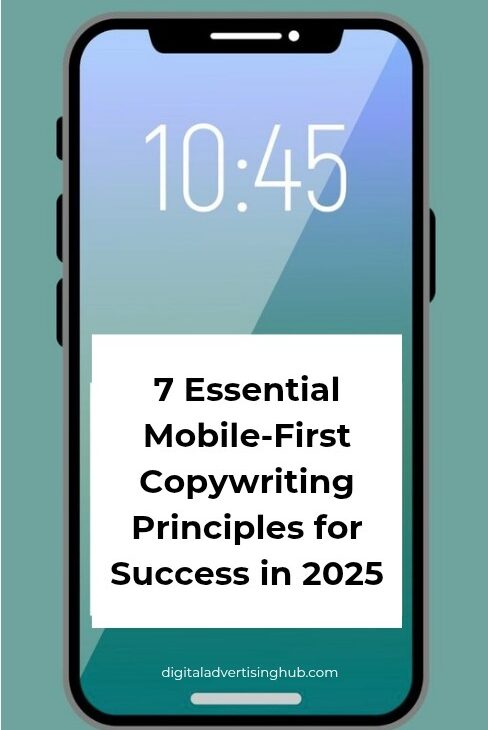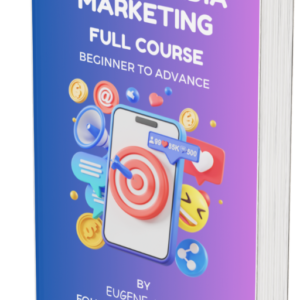In a rapidly shifting digital landscape, a strong mobile-first copywriting approach is not just desirable—it’s vital.
When users access content on smartphones, the way they read, scroll, and engage is fundamentally different from desktop.
That means every piece of copy must be crafted with those behaviors in mind.
By centring your copy around mobile experiences, you make your messaging clearer, more compelling, and far more likely to convert.
So, how do you do that?
#1. Understand Mobile-User Behavior to Inform Your Mobile-First Copywriting

Writing for mobile starts with empathy and insight: how do users behave when they’re on a small screen, on the go, or multitasking?
Understanding this sets the foundation for effective mobile-first copywriting.
Mobile users tend to scan rather than read deeply. Research reveals that online readers often skim rather than consume every word.
On mobile devices, paragraph breaks need to be shorter, headings must jump out, and context must be immediate.
For example, a long sentence may wrap several lines, making it difficult to follow; as the article on Medium notes, “Your copy on mobile is essentially doubled.
This turns a long sentence or two into a paragraph, taking up all screen space on a device.”
To inform a strong mobile-first copywriting practice, ask: What is the user’s aim when they open their phone? Are they browsing quickly? Trying to solve a problem fast? Or interacting while distracted?
Users often engage in shorter bursts, are more likely to switch apps or tabs, and have smaller windows of attention. Thus you must write with that context front and centre.
Segment your audience for mobile: Are they commuting? Waiting in line? Using one hand? These moments require copy that is concise and leads with value immediately.
When you write with mobile-user behavior in mind, your mobile-first copywriting becomes naturally aligned with the reality of how your content will be consumed.
That means shorter sentences, meaningful headings, clear CTAs, and prioritising clarity over stylistic flourish.
#2. Prioritise Clarity and Brevity in Your Mobile-First Copywriting
In a mobile context, every word carries weight. A cluttered sentence or bulky paragraph can lose attention—and losing attention means losing opportunity.
Thus, clarity and brevity are cornerstones of effective mobile-first copywriting.
First, simplify your sentences. Avoid complex constructions, multi-clause sentences, or jargon. Instead, write as you’d speak: direct, alive, responsive.
The sooner the reader grasps the benefit or idea, the sooner they act. So, as the Writing Cooperative pointed out: We need to get to the point.
Second, keep paragraphs short. On mobile screens, a paragraph of five or six full lines may feel like a wall of text.
A few lines—or even one line—is easier on the eyes and keeps the scroll moving. Use line breaks generously and don’t bury the main idea.
Third, highlight the benefit before detail. Mobile readers want to know what’s in it for them—fast. So you might lead with the result, then follow with how you deliver it.
The concept of benefits over features is well known, but on mobile it becomes even more critical because you must capture engagement before the scroll.
Fourth, use active voice and strong verbs. Passive phrases slow the reader down. On a small screen, every second counts.
A mobile-first copywriting mindset demands that you treat each line as real estate: make it earn its place.
In short, when you apply clarity and brevity to your mobile-first copywriting, you reduce friction, increase readability, and make every message matter.
#3. Structure Your Copy for Scannability in Mobile-First Copywriting
Mobile screens amplify the importance of structure. With limited space, readers often browse rather than fully consume.
That means your mobile-first copywriting must be arranged to facilitate scanning, jumping, and quick understanding.
Begin with a strong headline that delivers value. Because mobile users scroll fast, your headline must summarise the proposition clearly.
Then use subheadings to chunk the content logically—these act as signposts. In mobile-first copywriting, each subheading should address a single idea and guide the reader deeper.
You should also incorporate white space, bullet points, and shorter paragraphs.

Next, prioritise the inverted-pyramid structure: place the most important information first, then provide supporting details.
Use short, catchy titles and keep it short and sweet.
Images, icons or visual elements can help, but in mobile-first copywriting the visuals must not impede the flow.
They must be optimised for mobile screens, load quickly, and align with the copy’s message rather than simply decorate.
Also, ensure your CTA (call to action) is visible and clear. On mobile, a CTA buried under paragraphs may never surface before the user loses interest.
Your mobile-first copywriting should close the loop: headline grabs, subheading sustains, body explains, CTA directs.
By structuring your copy for scanning, you respect how mobile users engage—and you elevate readability, comprehension, and ultimately response.
#4. Adapt Language, Tone and Format for the Mobile-First Audience
Effective mobile-first copywriting isn’t just about shorter lines and tighter structure—it’s also about adapting language, tone and format to the mobile context.
The user mindset on mobile is different, and your copy needs to reflect that.
When people use mobile devices, they’re often distracted or multitasking. That means your tone should be conversational, direct, and friendly—not lofty or formal.
Imagine writing for someone glancing at a screen while commuting: your mobile-first copywriting must feel approachable and engaging.
Also, account for context of use. Mobile users may hold their phones with one hand, scroll quickly, switch apps, or tap distractedly.
So avoid requiring excessive reading or too much cognitive load.
Mobile experiences are often a series of micro interactions—quick tasks that the user performs, often in a highly distracting, public environment using a very small screen.
In terms of format:
#1. Use conversational phrases, rhetorical questions, or short bursts of insight to make your mobile-first copywriting more personable.
#2. Use contractions, as they reflect natural speech and reduce character count.
#3. Use imagery or iconography sparingly for mobile; the copy should stand strong on its own.
#4. Adjust for load times and screen size: avoid long paragraphs, heavy visuals, or unnecessary fluff.
Language choices must align with mobile demands: simple words, direct meaning, benefit-forward.
Format must align with mobile design: tap-friendly links, visible CTAs, responsive design.
When you adapt your copy in this way, your mobile-first copywriting feels native to the device rather than just a repurposed desktop text.
#5. Integrate SEO and Performance Metrics into Your Mobile-First Copywriting
While user experience is the primary concern in mobile-first copywriting, we cannot ignore performance: search engines, engagement metrics, conversion data—all play a role.
Integrating SEO and analytics into your approach makes your copy not just readable, but measurable.
First, ensure your content is mobile-friendly from an SEO standpoint. Google uses mobile-first indexing, meaning your mobile version of a page is the primary reference for ranking.
This reinforces that mobile-first copywriting must include relevant keywords, but above all must deliver value.
In your mobile-first copywriting, naturally incorporate keywords—without sacrificing readability or tone.
Keyword stuffing is self-defeating, especially on small screens where text density is already high.
Second, track engagement metrics that reflect mobile behavior: scroll depth, taps, click-through rate on mobile devices, dwell time, bounce rate on mobile.
Use analytics tools to compare how users engage with your copy on mobile versus desktop. Where you see drop-off, restructure accordingly.
Third, optimize for conversions: your mobile-first copywriting should lead to action. That might be a form submission, sign-up, purchase, download.
Ensure your CTA is mobile-visible and the path to conversion is short and clear. Monitor mobile conversion rate separately and refine copy based on performance.
Fourth, test and iterate. Use A/B testing on mobile headlines, subheadings, CTA wording, imagery. Track results.
Mobile device mix can change: screen sizes, operating systems, network speeds. Your mobile-first copywriting must evolve as those variables shift.
By merging user-centric writing with data-driven performance checks, your mobile-first copywriting strategy becomes both creative and accountable. You earn readability and results in parallel.
#6. Tailor Content for Mobile Context: Timing, Location and Interaction
Mobile usage brings unique context: people check phones anywhere—at home, in transit, at work, while multitasking.
That context influences how they read and how they respond. For mobile-first copywriting to succeed, you must tailor your content to these specific mobile moments.
Start by considering timing. Mobile users often engage in short bursts—checking during a commute, between tasks, while waiting.
This means your mobile-first copywriting must deliver value quickly. The headline must hook, the message must land, and the CTA must be obvious—all within those few seconds of attention.

Next, leverage location and device context. Mobile devices can provide signals—are users on the go?
Are they near a store? Do they have location enabled? In a mobile-first copywriting strategy, you can personalise content accordingly (e.g., “Find the nearest store in your area” or “Tap to see deals in your city”).
This makes the copy feel relevant, timely and actionable.
Also, consider interaction patterns: taps, swipes, one-hand usage, potential interruptions (calls, notifications).
Your mobile-first copywriting should be formatted to accommodate that: avoid heavy text blocks, use buttons large enough to tap, keep the path to conversion minimal.
Furthermore, think of micro-moments: “I want to know,” “I want to go,” “I want to do,” “I want to buy.”
Identify which moments your mobile audience is most likely in and craft your mobile-first copywriting accordingly.
If someone is in the “I want to buy” moment, your copy needs to facilitate that swiftly. If someone is in “I want to know,” the copy needs to educate without friction.
Finally, tailor your copy to network speed and device capability. Mobile readers may have slower connections or limited data.
That means avoid heavy assets, ensure your copy loads quickly, and structure the first lines to deliver value even if the rest hasn’t loaded fully.
When you tailor your content for mobile context, your mobile-first copywriting transcends mere adaptation—it becomes purpose-built for the environment in which it’s consumed.
That leads to stronger engagement, better conversion rates and more meaningful interactions.
#7. Evolve Your Mobile-First Copywriting with Emerging Trends and Tools
The mobile world is dynamic: new devices, new form factors, new behaviours, new channels. A modern mobile-first copywriting strategy must evolve to stay ahead.
First, keep an eye on emerging device types and screen sizes. Foldables, tablets, large-screen phones—all shift how users hold, read and interact.
Your mobile-first copywriting must test across form factors, ensuring legibility and format flexibility.
Second, leverage interactive and conversational formats. Chatbots, instant messaging, short-form video all play into mobile usage.
Your mobile-first copywriting should adapt: think micro-copy, in-app messages, swipeable modules, push notifications.
The Writing Cooperative article highlighted that mobile experiences are micro-interactions in distracting environments.
Third, integrate automation and personalization tools.
Many brands now use AI and dynamic content to tailor messages based on user behaviour, location, device, and previous interaction.
By doing so, your mobile-first copywriting can deliver messages that feel one-to-one and timely, increasing relevance and conversion potential.
Fourth, adopt voice search and conversational UI considerations. Mobile users increasingly use voice queries or hybrid voice-text search.
Copy must anticipate that and align accordingly: speaking in a natural, conversational tone, addressing questions users ask out loud.
Fifth, monitor analytics and adapt in real time. Mobile device behaviour can shift rapidly—network conditions, OS updates, privacy changes all affect how users engage.
Track performance, iterate your mobile-first copywriting regularly, and deploy updates quickly.
Finally, consider accessibility and inclusive design.
Mobile screens demand accessibility features: readable font sizes, sufficient contrast, easy navigation.
Your mobile-first copywriting must account for users with differing abilities, ensuring your messaging is accessible and readable across the board.
By evolving your mobile-first copywriting approach in line with trends and tools, you future-proof your content strategy and maintain relevancy in an increasingly mobile-centric world.
Conclusion
In 2025, crafting effective mobile-first copywriting is no longer optional—it’s fundamental.
By understanding how users behave on their devices, prioritising clarity and brevity, structuring your writing for scan-read patterns, adapting tone and format, integrating SEO and performance metrics, tailoring for the mobile context, and evolving with emerging trends, you can build copy that truly resonates and converts.
When you embed these seven principles into your content workflows, your mobile-first copywriting becomes a strategic asset—not just a channel-afterthought.
Whether you’re writing website copy, mobile app content, push notifications or social micro-ads, this approach ensures your message aligns with the device, the moment and the user.
That alignment is what leads to engagement, action and growth.
Remember: keep your mobile-first copywriting audience-centred, constantly test and refine, and stay responsive to how mobile behaviour continues to evolve.
With discipline and creativity, your messaging will thrive in the small-screen world where so many interactions now begin.










